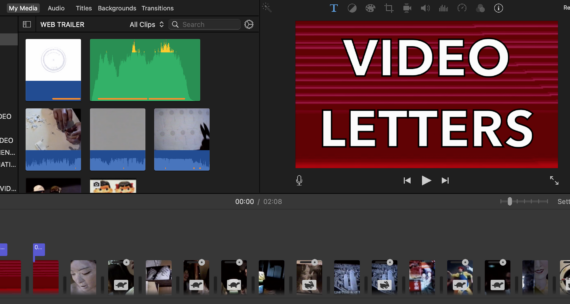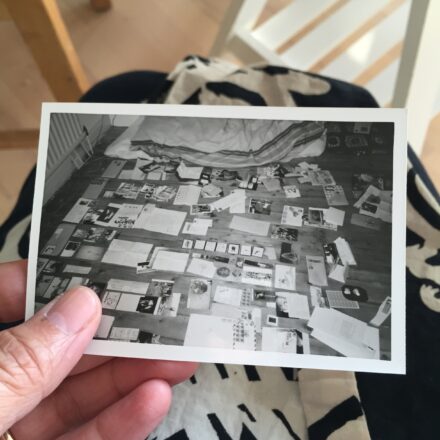
Video Letters
VIDEO LETTERS is a long film edited from Video 8 footage shot in nineties Osaka, Tokyo, Kyoto, New York, Toronto, London, Hanoi, Seoul, Lagos and Beijing, and stored in a box for 29 years.
The tapes were transferred and edited down into short ‘video letters’ to send to the people who appear in the tapes. The friends responded with texts and audio recordings that in turn became part of the final videos. Together these short videos become a journey and snapshot of the filmmaker’s changing life.
VIDEO LETTERSは、90年代に大阪、東京、京都、ニューヨーク、トロント、ロンドン、ハノイ、ソウル、ラゴス、北京で撮影されたビデオ8の映像から編集され、29年間箱に保管された一連の短編映画です。
テープは転送され、短い「ビデオレター」に編集されて、テープに登場する人々に送信されました。 友人たちはテキストと音声録音で応答し、それが最終的なビデオの一部になりました。
Sample extract from Video Letter – Beijing – Tape 15 – 1996 – Music by Jerry Gordon @moontriangle
The tapes are very affecting to watch, even without knowing the people in the videos. The material centres around the everyday lives of the video maker, and what she calls her own ‘video-mania’ of the time; a compulsion to use a camera to slow down and process the world around her.
テープは、ビデオの人々を知らなくても、見るのに非常に影響を与えています。 素材は、ビデオメーカーの日常生活と、彼女が当時の彼女自身の「ビデオマニア」と呼んでいるものを中心にしています。 カメラを使って彼女の周りの世界を減速させ、処理することへの衝動。
We see a group of friends living in an old wooden house in the suburbs of Osaka. In the absence of TV and Internet to entertain themselves, they live a communal, playful, and creative life planning and preparing for art, music, poetry and dance events that they held in local bars and galleries.
大阪郊外の木造住宅に住む友人たち。 テレビやインターネットがないので、彼らは地元のバーやギャラリーで開催したアート、音楽、詩、ダンスのイベントの準備をしながら、共同で遊び心のあるクリエイティブな生活を送っています。
What is not shown in the tapes is also poignant. One of the close friends, Ange, writes: “I was talking about the tapes. And about how much I clearly used to laugh. But we cried a lot too, Tan. It’s just not on the tapes.”
テープに示されていないものも痛烈です。 親しい友人の一人であるアンジュはこう書いています。「私はテープについて話していました。 そして、私がどれだけはっきりと笑っていたのかについて。 しかし、私たちもたくさん泣きました、タン。 テープには載っていません。」
Miyuki adds: “I’ve been watching with tears in my eyes.”
みゆきちゃんは「涙を浮かべて見ていました」と付け加えた。
Video-mania was at its peak during in 1993 and 1994, and the tapes resume again in 1996, with one year noticeably absent; 1995. This was the year of the Hanshin Earthquake, the Tokyo subway Sarin attack – and the year that the filmmaker was hospitalised to recover from corticosteroid dependency from years of treatment for chronic environmental allergies and anaphylaxis.
ビデオマニアは1993年と1994年にピークに達し、テープは1996年に再開され、1年は著しく欠席しました。 1995年。これは阪神大震災、東京の地下鉄サリン事件の年であり、慢性的な環境アレルギーとアナフィラキシーの長年の治療からコルチコステロイド依存症から回復するためにビデオメーカーが入院した年でした。
In one of the video letters we see the video-maker’s pen-pal of three years arriving at the house for the first time. We see his first weeks in Osaka, travelling on trains, learning to ride a bicycle again, meeting new people, and at home chatting or playing with projected images.
ビデオレターの1つに、ビデオメーカーの3年間のペンパルが初めて家に到着したのが見えます。 彼の大阪での最初の数週間は、電車で旅行し、再び自転車に乗ることを学び、新しい人々と出会い、家でチャットしたり、投影された画像で遊んだりしています。
Video Letters shows a special moment in time. There was little ‘thought’ in terms of filmmaking or messaging at the time they were taken.
ビデオレターは、特別な瞬間を示しています。 映画製作やメッセージングに関しては、ほとんど「考え」がありませんでした。
A lot of the tapes were made as video letters to friends in other countries. The video letters also became a natural extension of the pen pal letters exchanged between the two of the friends living in the house; part diary, part scrapbook, part sketch book, with loose ideas and observations juxtaposed together with pictures torn out of magazines, fragments of cut out sentences, quotes, photographs of low-fi artwork, and other traces of everyday life.
テープの多くは、他の国の友人へのビデオレターとして作成されました。 ビデオレターは、家に住む2人の友人の間で交換されたペンパルレターの自然な延長にもなりました。 一部の日記、一部のスクラップブック、一部のスケッチブック、雑誌から引き裂かれた写真、切り抜かれた文章の断片、引用、ローファイアートワークの写真、その他の日常生活の痕跡と並置されたゆるいアイデアと観察。
Despite the lack of planning, and haphazard low-fi quality of the images, an atmosphere of innocence shines through. It is hard to emphasize enough, even for those of us who were there, this was pre-internet; phone calls were expensive, faxes were more omnipresent than mobiles, and handwritten letters and postcards were still the most common form of personal communication.
計画の欠如, および画像の無計画なローファイ品質にもかかわらず、無垢な雰囲気が輝いています。 十分に強調するのは難しいです、そこにいた私たちにとってさえ、これはプレインターネットでした。 電話は高額で、ファックスは携帯電話よりも遍在しており、手書きの手紙やはがきは依然として最も一般的な個人的なコミュニケーション手段でした。
Just as photographs contain within them a time-stamp familiar to whole generations across cultures, the old video 8 triggers memories of a pre-Internet world. It was a time when the idea of Internet offered hope for connectivity, creative connection, and collaboration across traditional barriers of time, distance, and identity. It was also a time when the magnitude of climate change and biodiversity collapse were not widely understood.
写真に文化を超えて世代全体に馴染みのあるタイムスタンプが含まれているように、古いビデオ8はインターネット以前の世界の記憶を呼び起こします。 インターネットのアイデアが、時間、距離、アイデンティティの従来の障壁を越えた接続性、創造的な接続、コラボレーションへの希望を提供した時代でした。 また、気候変動や生物多様性の崩壊の大きさが広く理解されていなかった時期でもありました。
As one of the Video Letters friends, Helena, writes, “All those gems of uniqueness are hidden in these fragments of the everyday and mundane. These videos are a beautiful gift.”
ビデオレターの友人の一人であるヘレナは、次のように書いています。 これらのビデオは素晴らしい贈り物です。」
Another friend, Deniz, writes: “…I’m experiencing life as though I’m watching, living, reading, and speaking from a place of ‘no longer being’. As though I’m no longer here or may not be one day, sooner rather than some impossible unknown fictional date in the future. ..Back in 1994 we never contemplated the life continuum in that way, as though we would all live forever.”
別の友人であるデニスは、次のように書いています。 まるで私がもうここにいないか、1日ではないかもしれないかのように、将来の不可能な未知の架空の日付よりも早く。 .. 1994年に、私たちは皆が永遠に生きるかのように、そのように人生の連続性を考えたことはありませんでした。」
Shenyen writes:
“All but one of the films shown here are electronic postcards from a specific chunk of those pre-internet days — the early 1990s, the Far East — as she lived it with some of her friends.
「ここに示されている映画の1つを除くすべては、インターネット以前の特定のチャンク(1990年代初頭、極東)の電子ポストカードであり、彼女は友人の何人かと一緒に暮らしていました。
These were days when filming each other was practically unheard of. “How do people remember who don’t photograph, don’t film?” asks Chris Marker in his film “Sunless”.
お互いを撮影することは事実上前代未聞だった時代でした。 「誰が写真を撮らないのか、撮影しないのかをどうやって覚えているのですか?」 彼の映画「サンレス」でクリス・マルケルに尋ねます。
But in the age of overproduction, I think he would today be asking “How do people remember things who are surrounded by an endless stream of arbitrary images?” Memory cannot operate without “image”, but too much image and memory becomes jaded and rootless.
しかし、過剰生産の時代に、彼は今日、「人々は、恣意的なイメージの無限の流れに囲まれているものをどのように覚えているのか」と尋ねていると思います。 メモリは「イメージ」なしでは動作できませんが、イメージとメモリが多すぎると、無駄になり、ルートがなくなります。
In the “Osaka” pieces we see people engaged in the everyday magic of living, on the other side of the world, and the creativity and freshness it supports.
「大阪」の作品では、世界の反対側で日常生活の魔法に従事している人々と、それが支える創造性と新鮮さを見ることができます。
We see footage of Tan Kim’s first exhibition in Osaka — an exhibition itself focussed on letter writing and language and the physicality of memory. We see friends arriving in Osaka on one-way tickets to a new life.
タン・キムの大阪での最初の展覧会の映像を見ることができます。展覧会自体は、手紙の書き方と言語、そして記憶の物理性に焦点を当てています。 友達が新生活への片道切符で大阪に到着するのを目にします。
“Hanoi” is slightly different, and for me the most engaging and liberating of the video letters. Here, the nostalgia for a biography begins to dissolve into the simple joy of just motorcycling around a strange city, in love with the nothingness of our lives.
「ハノイ」は少し違いますが、私にとって最も魅力的で解放的なビデオレターです。 ここで、伝記への郷愁は、私たちの生活の無さを愛し、奇妙な街をバイクで回るという単純な喜びに溶け始めます。
The crowded kitchen of the other films gives way to an empty hotel bed. The faces of friends give way to .. well, the faces of friendly people we’ll never know.
他の映画の混雑したキッチンは、空のホテルのベッドに取って代わられます。 友達の顔は..まあ、私たちが決して知らない友好的な人々の顔に道を譲ります。
The music is perfect — both in terms of simple accompaniment and in the fact that it’s Hanoi being filmed. Because the film-maker’s innocent joy in just being there, travelling through the “impossible everyday” on a motorbike, is accompanied by chanting from Plum Village, the home of Thich Nhat Hanh’s exiled Vietnamese community.
音楽は完璧です-シンプルな伴奏とそれが撮影されているハノイであるという事実の両方の点で。 バイクで「不可能な日常」を旅する映画製作者の無邪気な喜びは、ティク・ナット・ハンの亡命したベトナム人コミュニティの本拠地であるプラム・ビレッジからの詠唱を伴います。
There are icebergs in Antarctica which possess postcodes: the last bureaucratic trace of long abandoned research bases in the 1960s.
南極には郵便番号を持っている氷山があります。1960年代に長い間放棄された研究基地の最後の官僚的な痕跡です。
Those “postcodes” are now floating slowly south, carrying nothing more than the air that breathes upon them, as they sail towards dissolution and oblivion.
それらの「郵便番号」は現在ゆっくりと南に浮かんでおり、溶解と忘却に向かって航海している間、それらに息を吹きかける空気だけを運んでいます。
This is “image”. This is what we talk about when we talk about memory and self. Self is a memory that we have domesticated, a motorbike — or an iceberg — carrying us through the nothingness of our lives. And if you’re lucky you may catch a glimpse of it before you die.
これが「イメージ」です。 これは私たちが記憶と自己について話すときに私たちが話すことです。 自己は私たちが家畜化した記憶であり、バイク、または氷山が私たちの人生の無さを運んでくれます。 そして運が良ければ、死ぬ前にそれを垣間見ることができます。

